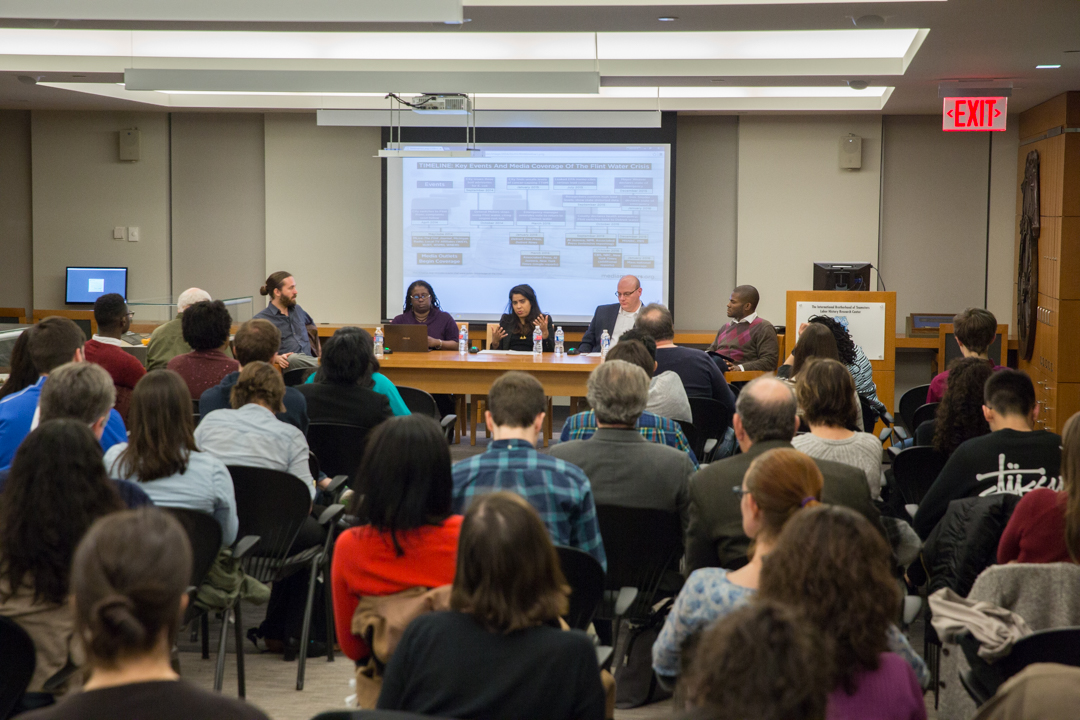By Ruth Steinhardt
Institutional racism and classism combined with an environment poisoned almost beyond repair and a lack of national media attention to create a state of emergency in Flint, Mich., this winter, according to a panel of experts convened at the George Washington University on Monday night.
A young crowd packed the International Brotherhood of Teamsters Room on the seventh floor of Gelman Library on Monday night, some sitting on the floor after every seat was filled. The choice of venue was appropriate, said Vice Provost for Libraries Geneva Henry, since the Teamsters “existed because they cared about the human condition and the well being of individuals.”
The audience had gathered for a panel discussion called “The Color of Water: A Teach-in on Flint, Michigan,” organized by GW’s Africana Studies Department, Sustainability Collaborative and American Studies Department. Five experts and activists outlined the complex ways in which issues of environmental and social justice interacted to make Flint’s crisis so severe.
Panelist Dimple Chaudhary, lead litigator for the Flint Litigation Team of the National Resources Defense Council, described the problems that have been facing Flint since long before the city’s struggles came to national attention.
Flint has been in state receivership since 2011, meaning that the local elected officials who would normally have addressed issues of municipal health were removed and replaced with state officials.
It was these state officials who, in April 2014, decided to use polluted, corrosive Flint River water for drinking purposes as a lower-cost alternative to buying water from Detroit, she said.
“The most critical decision, from a historical perspective, may have been to use that water without introducing corrosion-correcting chemicals,” Ms. Chaudhary said. “The [state appointees] overseeing this implementation decided not to do that.”
The water—which was 19 times more corrosive than Detroit tap water—dissolved and absorbed toxic substances such as lead as it flowed through Flint’s outdated pipe system.
Panelist Royce Francis, an assistant professor of engineering at the School of Engineering and Applied Science, said that these very concrete failures of the city’s physical infrastructure were caused by deeper prejudices.
In a higher-income area, he said, pipes containing substances as toxic as lead might not have been left in place for so long. As it is, however, Flint is one of many poor towns in the United States to experience dangerous levels of lead and other toxins. “Flint is a canary in the coal mine, and I fear we’re going to ignore the canary,” Dr. Francis said.
In the summer of 2014, Flint residents appealed to the state overseers about the look, smell and alarming side effects of the water. Even after E. coli and coliform bacteria were found in it, residents were only instructed to boil their tap water before drinking it.
By early 2015, the city issued an advisory warning about high levels of the toxic byproducts of the disinfectants used to combat the bacteria. The warning suggested that the elderly and sick should not drink large amounts of Flint water but that it was otherwise safe.
But residents were not satisfied. The water continued to look and taste strange, and its increasingly alarming side effects ranged from rashes and hair loss to vision and memory problems. The protests picked up.
At this time, said panelist Andrew Seifter, climate and energy program director for journalism watchdog Media Matters, only local and regional media outlets were covering Flint. It was not until the end of 2015—after the NRDC, the American Civil Liberties Union and local partner Concerned Pastors for Social Action announced their intent to sue the city and Michigan Gov. Rick Snyder (R) for violations of the Safe Drinking Water Act—that the story began to gain national traction.
Using a timeline created by Media Matters, Mr. Seifter pointed out that action could have been taken much earlier. Part of the problem, he said, was the crisis’ complexity, which made some journalists’ “eyes glaze over.” Another was the way that media attention was diverted by extensive coverage of the run-up to the presidential election.
“What we can all agree on is that January 2016 was much too late” to begin paying attention to Flint’s struggle, Mr. Seifter said. “There is a real human cost here when the national media are not keeping their eye on the ball.”
Panelist Jacqui Patterson, director of the NAACP’s Environmental and Climate Justice Program, said that a long history of racist practices had stripped Flint of the institutions that might have protected its residents.
Major manufacturers like General Motors monopolized and in some cases destroyed the city’s resources, she said, and once these manufacturers no longer had a stake in Flint, its citizens were virtually abandoned.
“Flint is a food desert, which means that lead poisoning had an even harsher impact,” she said. “Fruits and vegetables and good nutrition might have protected [residents]. But not only is there not one grocery store… [the food available] is actively not good for you.
“The infrastructure needed for any kind of resilience in this crisis was not there,” she said.
It is Flint citizens, themselves, Ms. Patterson said, who will lead the way out of it. The NAACP organized a series of community meetings, from which they created a 20-point list of priorities.
“It’s very clear that Flint knows what it needs in order to resolve this situation,” she said. “That points to the power of self-determination. If all of these things they are now asking for had been in place, we wouldn’t be in this situation.”


